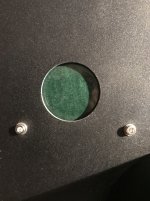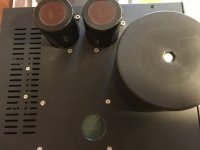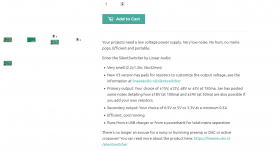Looking good!
It was only by following countless builds and reading way more than I remember on this forum that I got the inspiration and confidence to give it a go myself. What I love about this place is that there are so many out there willing to share and help out.
I think my next problem may be justifying to my better half why I need two or three preamps and three or four power amps!
Gary
That is a very nice build, can you please share how you created the hole for the display.
Thanks
Oh yes, I won‘t do it more than once neither. (Once will be remembered as fun and my grandchildren will tell this story to their friends, whispering)
I‘m already on the hunt for a decent tabledrill 😀
And, Margol, I use a drill like the first you posted, but without a tabledrill/drillpress, it’s close to hell (like, purgatory?).
BUT: I‘m already kinda proud of what I already got!
I‘m already on the hunt for a decent tabledrill 😀
And, Margol, I use a drill like the first you posted, but without a tabledrill/drillpress, it’s close to hell (like, purgatory?).
BUT: I‘m already kinda proud of what I already got!
or if you have a drill press something like this?
I can vouch for the hole saw margol showed in post #2400.
Works very well in combination with a drill press. I got an inexpensive one, like Mark, it wobbles a bit, but gets most holes round and at the proper diameter 🙂
Especially with the hole saw with its large contact surface, the drill press works very well.
You have to use cutting fluid, though.
The hole saws even makes beautiful cutouts in steel, much more easily than with a drill bit.
The drawback is that you have to buy a hole saw for each different diameter. But Amazon has them for not much money. And you can remove the center part and use that for each hole saw.
I have the stepped bit, as well, and used it once or twice. But I don't like it at all; the hole saw works so much better 😉
Regards, Claas
Yes. The cutting fluid is a must. As for the steped drill, it can be used free hand with some practice and given the work pice is very well secured. I would prefer steped drill for aluminium up to 3mm and for steel back plate
Interesting. Understanding how to cut big(ish) round holes successfully depends a lot on experience it seems.
My brother was cutting out a round tabletop out of plywood and I suggested that he use a 1/4" bit rather than the 3/4" one so that the "cut" was narrower and would involve less sawdust and easier passage. Someone on diyaudio argued that it was better to use a wider bit (don''t recall the reason now) so that's what we did. Worked great.
Here, it seems to me that the hole saw is ideal.
And you get a nice washer as a by-product. (My chief experience with a hole saw has been to cut washers out of UHMW polyethylene)
My brother was cutting out a round tabletop out of plywood and I suggested that he use a 1/4" bit rather than the 3/4" one so that the "cut" was narrower and would involve less sawdust and easier passage. Someone on diyaudio argued that it was better to use a wider bit (don''t recall the reason now) so that's what we did. Worked great.
Here, it seems to me that the hole saw is ideal.
And you get a nice washer as a by-product. (My chief experience with a hole saw has been to cut washers out of UHMW polyethylene)
Using a standard drill bit or the stepped drill for steel, I always found there was some risk of warping. That was not a problem with the hole saws I used (from 15 mm to over 40 mm diameter).
I used a support under the plate, and was safe from the risk of warping it.
Getting through with a hand-driller was difficult enough—a moment of distraction and the drill wedges into the aluminium, throwing me around the workspace [emoji3061]
Getting through with a hand-driller was difficult enough—a moment of distraction and the drill wedges into the aluminium, throwing me around the workspace [emoji3061]
Large drill bit into steel sheet, say hole of 10 mm diameter or so ... ideally I drill it clamped between to sacrificial pieces of wood ...
If you ever work with stainless steel, the stepped drill is the only way to go, flooded with coolant. I work with stainless quite a bit for my brewing hobby. Putting a 7/8" hole in a stainless beer keg is not easy without a stepped drill. Slow rpm on bit, lots of pressure and flood with garden hose to keep everything cool, cuts like butta.
This is from one of my PSUs - Modushop Galaxy case, 1 mm steel covers.
Cutouts made with hole saws - the empty one is 32 mm diameter; had been used for a 5C3S / 5U4G rectifier. The cutouts for the capacitors are 50 mm diameter. 😀
Made using a basic drill press; the steel cover clamped to a piece of wood; some cutting fluid at the start.
Regards, Claas
Cutouts made with hole saws - the empty one is 32 mm diameter; had been used for a 5C3S / 5U4G rectifier. The cutouts for the capacitors are 50 mm diameter. 😀
Made using a basic drill press; the steel cover clamped to a piece of wood; some cutting fluid at the start.
Regards, Claas
Attachments
Today, I made the 3rd hole (30 mm with a stepped drill, still no drillpress).
It is tedious, and since doing it without a proper guide/grip, it is also difficult to keep it at center-position—progress-control at every step, with manual corrective measures. (I fear the knobs will end up ~1 mm off centerline which will be visible).
I think I have to invent a special effect to make it worth it 😀
When I got the hole properly set, I went to the art-museum with the family to distract myself.
It is tedious, and since doing it without a proper guide/grip, it is also difficult to keep it at center-position—progress-control at every step, with manual corrective measures. (I fear the knobs will end up ~1 mm off centerline which will be visible).
I think I have to invent a special effect to make it worth it 😀
When I got the hole properly set, I went to the art-museum with the family to distract myself.
Last edited:
Silent switcher would work beautifully.
Would there be much of a benefit to converting the Silent Switcher to 18V or would the default 15V be sufficient?
Considering 6L6's comment (15 - 20 V is all fine), probably not.
I'd say only the comparison of 2 SilentSwitchers could really confirm it, but I'm not sure about the feasibility of "modding" a built silentswitcher (from 15V to 18V), and what if the first variation was the better one?
I'm still a bit intimidated by those SMD-particles, but will get my shoot at as soon as I can (which will be in a quite distant future considering the build-list and my pace)...
I'd say only the comparison of 2 SilentSwitchers could really confirm it, but I'm not sure about the feasibility of "modding" a built silentswitcher (from 15V to 18V), and what if the first variation was the better one?
I'm still a bit intimidated by those SMD-particles, but will get my shoot at as soon as I can (which will be in a quite distant future considering the build-list and my pace)...
to my leftear #2414
Hello my leftear,
you can modify the 'silent switcher' from Jan Didden to higher voltages like
18V (and higher). It depends on the max. voltage of the OPAmp used.
Greets
Dirk
Hello my leftear,
you can modify the 'silent switcher' from Jan Didden to higher voltages like
18V (and higher). It depends on the max. voltage of the OPAmp used.
Greets
Dirk
Yes, but this means swapping parts doesn‘t it? (Which is even more intimidating than building the little bugger [emoji4])
Ok, adding resistor might be something different...
Ok, adding resistor might be something different...
Yes, 15V is the default for the Silent Switcher, but 18V requires desoldering 4 SMD resistors, buying 4 new ones, and soldering them. It took me a little while to find the relevant info in post 135:
SilentSwitcher - mains-free +/-15V and 6/5/3.3V power
Desoldering and soldering SMD resistors on a working power supply isn’t something I want to do unless there’s a big sonic benefit. And I suspect given Wayne’s specs that 15V vs 18V is a minimal difference. But I know some members have compared power supply voltages, so I thought I’d ask....
SilentSwitcher - mains-free +/-15V and 6/5/3.3V power
Desoldering and soldering SMD resistors on a working power supply isn’t something I want to do unless there’s a big sonic benefit. And I suspect given Wayne’s specs that 15V vs 18V is a minimal difference. But I know some members have compared power supply voltages, so I thought I’d ask....
Last edited:
Here‘s 6L6 statement on that matter:
https://www.diyaudio.com/forums/pass-labs/329240-waynes-ba-2018-linestage-97.html#post6079338
https://www.diyaudio.com/forums/pass-labs/329240-waynes-ba-2018-linestage-97.html#post6079338
- Home
- Amplifiers
- Pass Labs
- Wayne's BA 2018 linestage


